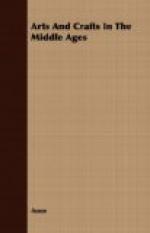Certain armourers were very well known in their day, and were as famous as artists in other branches. William Austin made a superb suit for the Earl of Warwick, while Thomas Stevyns was the coppersmith who worked on the same, and Bartholomew Lambspring was the polisher. There was a famous master-armourer at Greenwich in the days of Elizabeth, named Jacob: some important arms of that period bear the inscription, “Made by me Jacob.” There is some question whether he was the same man as Jacob Topf who came from Innsbruck, and became court armourer in England in 1575. Another famous smith was William Pickering, who made exquisitely ornate suits of what we might call full-dress armour.
Colossal cannon were made: two celebrated guns may be seen, the monster at Ghent, called Mad Meg, and the huge cannon at Edinburgh Castle, Mons Meg, dating from 1476. These guns are composed of steel coils or spirals, afterwards welded into a solid mass instead of being cast. They are mammoth examples of the art of the blacksmith and the forge. In Germany cannon were made of bronze, and these were simply cast.
Cross bows obtained great favour in Spain, even after the arquebuse had come into use. It was considered a safer weapon to the one who used it. An old writer in 1644 remarks, “It has never been known that a man’s life has been lost by breaking the string or cord, two things which are dangerous, but not to a considerable extent,"... and he goes on “once set, its shot is secure, which is not the case with the arquebus, which often misses fire.” There is a letter from Ambassador Salimas to the King of Hungary, in which he says: “I went to Balbastro and there occupied myself in making a pair of cross bows for your Majesty. I believe they will satisfy the desires which were required... as your Majesty is annoyed when they do not go off as you wish.” It would seem as though his Majesty’s “annoyance” was justifiable; imagine any one dependent upon the shot of a cross bow, and then having the weapon fail to “go off!” Nothing could be more discouraging.
[Illustration: ENAMELLED SUIT OF ARMOUR]
There is a contemporary treatise which is full of interest, entitled, “How a Man shall be Armed at his ease when he shall Fight on Foot.” It certainly was a good deal of a contract to render a knight comfortable in spite of the fact that he could see or breathe only imperfectly, and was weighted down by iron at every point. This complete covering with metal added much to the actual noise of battle. Froissart alludes to the fact that in the battle of Rosebeque, in 1382, the hammering on the helmets made a noise which was equal to that of all the armourers of Paris and Brussels working together. And yet the strength needed to sport such accoutrements seems to have been supplied. Leon Alberti of Florence, when clad in a full suit of armour, could spring with ease upon a galloping horse, and it is related that Aldobrandini, even with his right arm disabled, could cleave straight through his opponent’s helmet and head, down to the collar bone, with a single stroke!




